

Information Technology (IT) Pioneers
Retirees and former employees of Unisys, Lockheed Martin, and their heritage companies
Antenna Coupler Engineering, Chapter 41
1. Introduction
 This Legacy chapter discusses the early ERA non-computer
products, the most successful of which was the Antenna Coupler
series. Unfortunately; Harry, Marc, and Warren who wrote about these
ERA products have passed away.
This Legacy chapter discusses the early ERA non-computer
products, the most successful of which was the Antenna Coupler
series. Unfortunately; Harry, Marc, and Warren who wrote about these
ERA products have passed away.
ERA also built some Ground Support Equipment (GSE) for airlines using Crosley vehicles as the base.
2. Antenna Couplers
The Automatic Antenna Coupler production provided cash flow to keep the plants open in the '50s and early '60s. Couplers were needed for long range over the ocean communications. As illustrated on below right for the KC-135, tail tops or wing tip installations were common. Three 'HAM' radio operators contacted us in 2008, inquiring about surplus store couplers to use with their home systems. Marc Shoquist's oral interview provides more personal insight into this product as does Warren Becker's mini-biography. [lab]
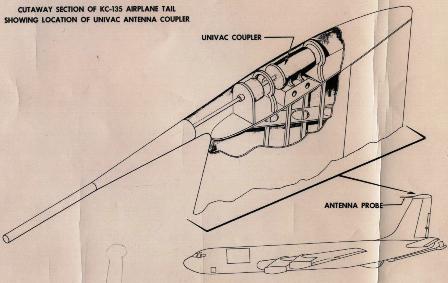 2.1
The Antenna Coupler Program
2.1
The Antenna Coupler Program
Contributed by Marc Shoquist, Project Engineer on Antenna Coupler Development - 1951 U of MN graduate, Electrical Engineering. Joined ERA in 1953 [34 years with ERA/Sperry]
ERA took on many study contracts from the
government during its early years and one of the most successful was
the Antenna Coupler program which resulted in the production of over
12,000 units for military and commercial aircraft communication systems
during the 1953 – 1970 period, after which the program was transferred
to Sperry Marine Systems. It was the largest production program ERA
had in the mid 1950’s and during the 1953 – 1956 period
represented over 25% of the sales and most of the profits for the division.
During the 1953 – 70 period, there were three generations of antenna
couplers developed; the initial model which used vacuum tubes, an all
solid- state unit for the Boeing Jet aircraft developed in 1955, and
finally a high tuning speed unit for the General Dynamics B-58 Hustler
Bomber developed in 1958.
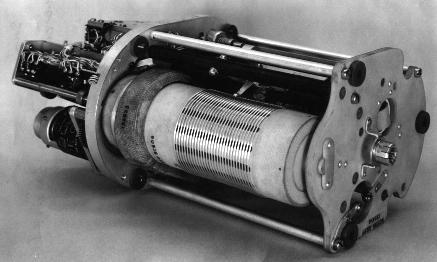 The coupler consisted of a variable vacuum capacitor and inductor coil,
each driven by servo motors which were tuned to automatically match
the antenna impedance to the coaxial transmission cable. The tuning
elements were controlled by a discriminator which sensed the resistance
and phase at the termination of the coaxial cable to the antenna. The
coupler tuned wire, probe and tail cap antennas in the High Frequency
(HF) 2-30 MHz range. The Boeing 707 used a probe antenna mounted on top of
the tail fin so the coupler was exposed to the outside environment where
temperatures were frequently below – 65 degrees F. Moreover, the
coupler after being in a cold soak at this temperature had to start
up an complete the tuning within 10 seconds, a no easy task. In addition,
the probe antenna impedance was so miss-matched at low frequencies that
the coupling voltage to the antenna was over 20,000 volts. The early
units were pressurized with dry nitrogen and sealed with a soldered
seal. Later a Teflon coated O-ring seal was developed which was able
to hold a vacuum over a long period, thereby simplifing maintenance of
the unit.
The coupler consisted of a variable vacuum capacitor and inductor coil,
each driven by servo motors which were tuned to automatically match
the antenna impedance to the coaxial transmission cable. The tuning
elements were controlled by a discriminator which sensed the resistance
and phase at the termination of the coaxial cable to the antenna. The
coupler tuned wire, probe and tail cap antennas in the High Frequency
(HF) 2-30 MHz range. The Boeing 707 used a probe antenna mounted on top of
the tail fin so the coupler was exposed to the outside environment where
temperatures were frequently below – 65 degrees F. Moreover, the
coupler after being in a cold soak at this temperature had to start
up an complete the tuning within 10 seconds, a no easy task. In addition,
the probe antenna impedance was so miss-matched at low frequencies that
the coupling voltage to the antenna was over 20,000 volts. The early
units were pressurized with dry nitrogen and sealed with a soldered
seal. Later a Teflon coated O-ring seal was developed which was able
to hold a vacuum over a long period, thereby simplifing maintenance of
the unit.
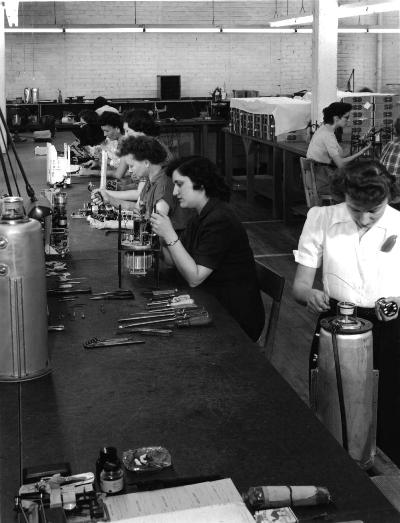 In the early 1950’s RCA won an Air Force contract for the development
of the new ARC-21 Airborne HF Communication System which included an
antenna coupler. During its development, RCA experienced problems in
developing the antenna coupler and the Air Force gave ERA a study contract
as a fall back. The ERA coupler proved to be superior to the RCA unit
thus ERA became the sole source production supplier of the coupler for
the system. Initially, it was sold directly to Boeing who sold it as “contractor
supplied equipment” in aircraft delivered to the Air Force. Over
7,000 units were sold to the Air Force during the 1953-70 period and
were used on about 10 different aircraft. The Coupler assembly
line is shown at the right.
In the early 1950’s RCA won an Air Force contract for the development
of the new ARC-21 Airborne HF Communication System which included an
antenna coupler. During its development, RCA experienced problems in
developing the antenna coupler and the Air Force gave ERA a study contract
as a fall back. The ERA coupler proved to be superior to the RCA unit
thus ERA became the sole source production supplier of the coupler for
the system. Initially, it was sold directly to Boeing who sold it as “contractor
supplied equipment” in aircraft delivered to the Air Force. Over
7,000 units were sold to the Air Force during the 1953-70 period and
were used on about 10 different aircraft. The Coupler assembly
line is shown at the right.
I joined the company in 1953 at
the time the first generation coupler was entering production. The coupler
engineering staff at that time was small and headed by Fran Biltz under
the Communications Group directed by Carl Swanson. Other staff engineers
included Leon Sabine, Robert Einfeldt, Bruce Sifford, Manny Block, Howard
Peterson, and two technicians, Morris “Pappy” Pappenfuss
and Oscar Haymen. Carl Hiat, a development engineer had transferred
to manufacturing to assist in the transition of the Coupler into production.
Fred Hargesheimer headed marketing and Don Blattie did the contracting.
Al Meuller led Customer service, which included the training of the
supervisors and technicians of the foreign airlines' maintenance shops.
{Editor's note: Al was the first VIP Club President in 1980.}
My initial coupler assignment was conducting the
Qualification Test of the coupler and writing the report. Later I was
the field test engineer for system tests of the Arc 21 communication
tests on the B-47 aircraft at McDill Air Force base. This was followed
by my supervision of a coupler field modification program at Smoky Hill
Air Force base in Kansas. I returned in 1955 to head a development group
and became the project engineer for the 2nd generation coupler which
was developed for the Boeing 707 aircraft.
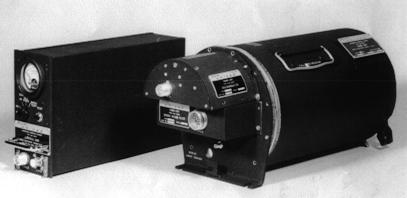
In 1955, Boeing developed the 707 Commercial jet aircraft and based on the performance of the ERA Coupler awarded ERA the contract to develop the coupler without a competition. This launched the development of the 2nd generation all solid-state coupler, which was the first of its type in industry. The Boeing 707 initiated Boeing’s return to the commercial aircraft business, which they continue to lead as the world’s largest supplier. The 707 was sold to over 40 airlines worldwide and there was an ERA coupler on every one of them. This was the model 3250 shown at the left. The tube-like unit was mounted either in the vertical stabilizer or at the end of a wing. The control unit [rectangular box] was mounted adjacent to the radio set.
One of the highlights of the military business
was supplying the couplers for the Presidents' Air Force One planes.
There were six couplers including spares on every aircraft and their
installation received special treatment by our engineers and field service
staff. Robert Brown, who led our field service group made the initial
installation in 1956 at Boeing before they were delivered. The system
was upgraded in 1965 and Ernie Griffith, a lead engineer on the coupler
project,
did the installations at Andrews Air Force Base near Washington DC where
the fleet of Presidential aircraft and helicopters are based. I went
along to chat with the Boeing representatives and just touring this
specially equipped aircraft was worth the trip.
I was project engineer for the 3rd generation coupler for
the Air Force B-58 Hustler Bomber.
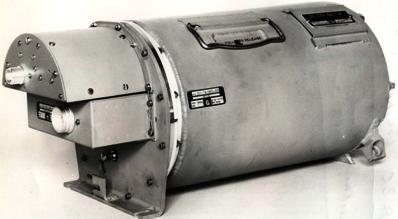 By the time the B-58 Coupler contract
was won in 1958, the engineering staff which then included drafting
had grown to 70 people and engineers which were added for the 707 project
development included John Moe, Charles Class, Allen Anderson, Mick Alsop,
Al Sorenson, Paul Richardson, Howard Chen, and Bob Rife.
By
this time, the division had become recognized as a specialist in the
development of this product to the extent that when Hughes won the contract
for the development of the new ARC-68 HF Communication system, they
selected us as the coupler supplier, rather than develop it themselves.
By the time the B-58 Coupler contract
was won in 1958, the engineering staff which then included drafting
had grown to 70 people and engineers which were added for the 707 project
development included John Moe, Charles Class, Allen Anderson, Mick Alsop,
Al Sorenson, Paul Richardson, Howard Chen, and Bob Rife.
By
this time, the division had become recognized as a specialist in the
development of this product to the extent that when Hughes won the contract
for the development of the new ARC-68 HF Communication system, they
selected us as the coupler supplier, rather than develop it themselves.
While the initial coupler business was with the Air
Force and Boeing, in 1967 the company was successful in displacing Collins
Radio as the supplier of the Coupler on the Lockheed P-3C Patrol aircraft
for the Navy. Winning this contract was a milestone in extending the
airborne coupler business to other services. In 1984, I visited Sperry
Marine systems 15 years after the the Coupler Business had been transferred
to them. Supplying couplers for the P-3C was the major source of
their revenue for their coupler military business. The P-3 coupler is
shown here at the left. [Marc Shoquist]
![]()
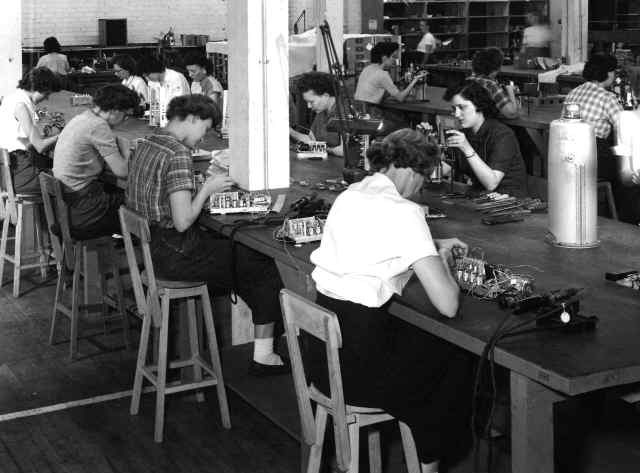 The antenna coupler is very much a part of the military history of ERA/Univac/LM.
I think that the first one was designed for the KC-130 "flying filling
station", the prototype of the Boeing 707. The USAF let Boeing build
three 707s on government tooling and then made Boeing build their own
tooling for the commercial plane. This gave Boeing several years to
test fly those planes. In the early 1930's Boeing had built a few prototype
B-17s. The depression stopped the production. A Dr. Reynolds invented
modern flight testing and spent years working on those prototypes. That
is why the B-17 was such a good plane. Dr. Reynolds designed the B-29
at the start of WW II. The first prototype killed him. His niece worked
for Remington Rand Univac about 1958. I met her because her parents
lived across the street from my parents in Tegucigalpa, Honduras. It's
a small world. At one time Margaret might have been the most knowledgeable
person in the plant on transistor physics as a result of her programming
in that area. [Harry Wise]
The antenna coupler is very much a part of the military history of ERA/Univac/LM.
I think that the first one was designed for the KC-130 "flying filling
station", the prototype of the Boeing 707. The USAF let Boeing build
three 707s on government tooling and then made Boeing build their own
tooling for the commercial plane. This gave Boeing several years to
test fly those planes. In the early 1930's Boeing had built a few prototype
B-17s. The depression stopped the production. A Dr. Reynolds invented
modern flight testing and spent years working on those prototypes. That
is why the B-17 was such a good plane. Dr. Reynolds designed the B-29
at the start of WW II. The first prototype killed him. His niece worked
for Remington Rand Univac about 1958. I met her because her parents
lived across the street from my parents in Tegucigalpa, Honduras. It's
a small world. At one time Margaret might have been the most knowledgeable
person in the plant on transistor physics as a result of her programming
in that area. [Harry Wise]
The photo at the right was taken in the 1950s at the then ERA plant
3, located on University Avenue between the Cleveland and Raymond intersections.
2.2 Business Aspects by Shoquist
I had mentioned that the Coupler was one of the primary production programs that ERA/RRU had during the 1950's and was very profitable. Over 12,000 couplers were manufactured during the 1953 to 1970 period when the program was transferred and continued at Sperry Marine in Charlottesville, Va. Fiscal year 1957 [April 1, 56 - March 31, 1957] was one of its most profitable years, and I can recall Art E. Johnson from the controllers department calling the Coupler Engineering managers together to review the results. He distributed the following financial data which I have kept all these years. He opened his remarks saying that the St. Paul Division had total sales of about $ 40M that year with the Coupler contribution as follows:
- Coupler Sales as percentage of total sales 38%
- Coupler Profit as percentage of total profit 88%
- Coupler Return on Sales 40%
- Division Return on total Sales 3.5%
- Coupler Return on Investment 163%
- Division Return on Investment 13%
- Coupler Return per Professional Employee $162,000
This was the year that the new plant was opened on West 7th Street,
and Wm. Norris would say it wouldn't have been built but for the coupler
profits. Only the western quarter of the plant was air conditioned for
the two stories. It is no wonder that the Coupler Engineering staff
occupied the south/west quarter of the air conditioned section on the
first floor. The number of people in this section was over 70, including
assigned draftsmen. At that time we were developing the 2nd generation
couplers, which were all solid state and were for the Boeing 707 jet
aircraft and its military derivative, the KC-135 cargo and tanker aircraft.
We had also just won the coupler development from Hughes Aircraft for
the new 1 KW HF Communications System for the GD B-58 Bomber [Hustler].
I can remember over 70 people attending the annual Coupler Christmas
party that year [1956]. Somewhere I have the attendance list.
{Side
note: Webmaster Lowell Benson began his technology career in the
Antenna Coupler department in July, 1960 as a drawing control clerk
- doing paper work for engineering change orders. In the spring of
1961, management moved the antenna coupler engineering department to
plant 5 in the midway area. }
A Production summary is shown in this table.
| Series | Time Frame | Customer | Aircraft | Quantity |
| 3000 | 1953 - 1959 | Boeing and General Dynamics | Bombers & VC-137 President's aircraft | 7000 |
| 3250 | 1958 -1970 | Boeing | 707/KC-135 | 3500* |
| 3300 | 1958 - 1962 | General Dynamics | B-58 Hustler** | 180 |
| 1809 | 1968 - 1984 | Lockheed | P-3C | several 100*** |
| 4000 | 1963 -? | Air Force | Minuteman mobile installation | ? |
*Additional 3250 series units built at Sperry Marine
after 1970.
**Nose probe antenna.
***Mostly at Sperry Marine after 1970
![]()
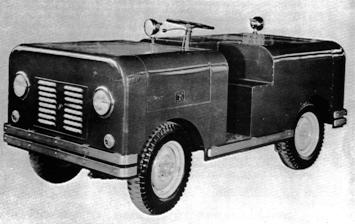 3.
Crosley-based Ground Support Equipment
3.
Crosley-based Ground Support Equipment
Shown at the right is a Crosley based fueling vehicle which was sold for use at small airports in the late 40's. This was part of the work that Parker brought to the plant because of his previous affiliation with Northwest Airlines. [lab]
I may still have a picture of the ERA Honey Wagon. It was based on a Crosley automobile "strip down": chassis, engine, transmission, running gear, etc., reference http://www.ggw.org/. When I first came to Remington Rand Univac in 1956 there were still Crosley parts tucked into corners around the old plant. [Harry Wise]
4.0 Doppler Wind Drift Indicator
{Editor’s note: This story by Glen Turner originally appeared in the VIP Club newsletter in April 1990, contributed to the Legacy Project by Ed Nelson. The Newsletter editor at that time was William ‘Curt’ Nelson.}
This is a story written to clear my conscience. A couple years ago, I told Curt that I would write a piece about one of the projects I was on back in the early 1950s. Now with the completion of this I can face him without feeling guilty. I started at ERA in November 1950 right after 4 years of school on the GI bill of rights. I was hired by Bob Patterson after being interviewed by Ken Bergan and Ken Bush. {Editor's note: Ken Bush's son Tom and grandson Steve both became employees of UNIVAC/UNISYS} I went to work on a project that had nothing to do with computers which was not unusual in the early days of ERA. My introduction to ERA was on a project called “The Doppler Miss Distance Indicator” (Project 2021, if my memory serves me right.) It was of all things, a radar to detect how far a bullet missed a target.
The project was classified Confidential and the project manager, Mr. Bergan impressed on me that I was not to discuss the project outside the hallowed halls of that old glider plant. My wife couldn’t understand why I couldn’t even confide in her what I was working on. To this day, I get an occasional needle about that secrecy.
I was assigned to design a 20,000 volt power supply for the magnetron for the X-Band radar. Until my clearance came through, I could not even see the radar for which I was designing the power supply. In fact, we drilled a hole in the wall to feed the wires through so the other project people in another room could test their equipment while I ran tests on the power supply. Mr. Bergan must not have been too happy with my cavalier attitude about how I worked around that power supply because he went to the library and got an article on electrocution and made it required reading for me and anyone that worked with me. Some names that come to mind on the project are John ‘Art’ Engstrom, Lowell Johnson, Wally Moe, Carl Hyatt, Manny Block, ‘Ski' Zarembinski, Bob Rhode, Al Mueller, Morris Papenfuss, Bob Einfeldt, Leon Sabine, Alton O. Christenson, John Reedy, John Zavaski, Bob Groschen and many more that will undoubtedly let me know that they worked that program too.
After being on the project for a month; I was introduced to the Monthly Project Report. Being just out of school, I wrote a report that could have been a good start on a thesis on power supplies for air borne radars. It was incorporated in the report and set up for review by a Mr. Coombs. He decided it was too verbose, and I heard him come down the hall asking for that new kid. He told me my part of the report was bigger than all the rest of the report put together and I would have to pare it down. Then they ran into a problem – it had been classified, and I couldn’t even see my own report. Mr. Bergan made the corrections.
Testing the radar as it was being built was a challenge. The antennae were set up in the hallway, and we fired Ping-Pong balls down the hall to attempt to simulate bullets. This was fun but not very successful. John Reedy then built a horizontally rotating ‘barber pole’ with a metallic strip painted on it. This worked well enough to get us to the point where it was ready for testing with real bullets.
Arrangements were made with the Arms Plant in New Brighton for the project to set up the radar antenna and fire 50 cal. Machinegun bullets past it. The data reduction equipment was set up in the gun room. Zarembinsi had experience in WWII, so he was our gunner. Numerous trips were made out to the firing range after making engineering changes. [That’s engineering talk for we didn’t do it right the first time.] We spent so much time at the Arms Plant that the people in charge of the firing range just ignored us and let us do our thing. That turned out to be a mistake on their part. Although the gun was fired in a single shot mode, in time all the sand that absorbed the bullets was blasted away and eventually a hole was made in the back of the cement bunker. The result was that one day a tracer bullet went out of the back of that bunker and set the dry grass on fire. The fire departments from the Arms Plant, Spring Lake Park, and New Brighton were required to put out the blaze we had started. Needless to say, we were closely supervised by the range people after that.
Although the equipment was designed to be installed in a target drone aircraft, it was never tested in the air. Bob Rhode and I took the final equipment to Eglin Field for installation and acceptance testing. Range time was tough to get there in Florida so Bob and I forced ourselves to boat, swim, and fish to kill time until we could demonstrate the ability of the unit to measure miss distance.
While were down there, I was call into General Mechling’s office. I thought it was to report on our progress, but the General used me to announce that ERA had been picked to furnish an 1103 Computer for the Air Force. I didn’t know an 1103 from a Model T Ford, so I headed for a phone and called Arne Cohen, and told him what I had just been told.
The Doppler Wind Drift Indicator was accepted by the Air Force, and
like many of those early ERA projects, it was never heard of again.
Glen Turner.
![]()
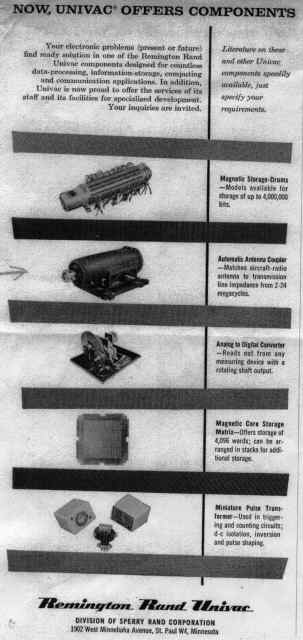 5. Others
5. Others
As for other RRU airborne products, an advertisement in a military publication associated with the annual Aeronautical Electronics Conference in Dayton, Ohio, featured the following products:
- Magnetic Storage Drums
- Automatic Antenna Couplers
- Analog-to-Digital Converter
- Magnetic Core Storage Matrix
- Miniature Pulse Transformer
I presented one of the 122 papers at this conference, which was featured in the same publication. [Marc Shoquist]
This UNIVAC advertisement at the right was scanned from the 1956 Military Electronics magazine shows Magnetic Storage Drums, Automatic Antenna Coupler, Analog to Digital Converter, Magnetic Core Storage (core plane shown), and Miniature Pulse Transformers. [lab]
Been reading lately and ran across this. Larry Bolton
In a book “The Lake Superior Iron Ore Railroads” by Patrick Dorin, 1969, on page 70-71 in describing the operation of the Great Northern Railway in the Duluth/Superior area, he writes:
“The General Yardmaster has the responsibility of the humping and classification of the road trains. The cars are weighed automatically while being humped. As each car nears the crest of the hump and on to the scale, a console operator punches on a keyboard the car number. A Univac computer pulls the tare weight of the car from its memory and a tape is punched in the ore dock office showing the net weight of ore in the car. This tape is then used to produce punch cards to be used for records such as block lists, mine waybills and ore vessel reports.”